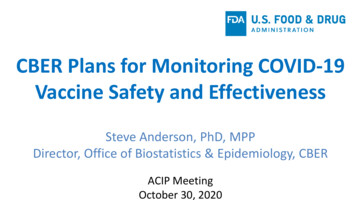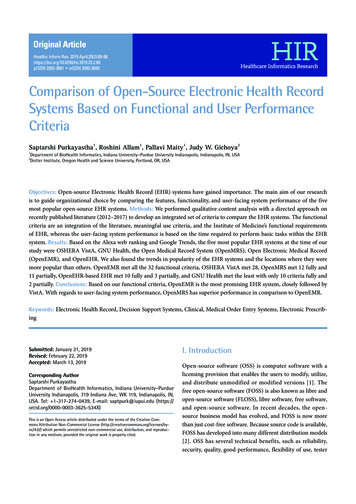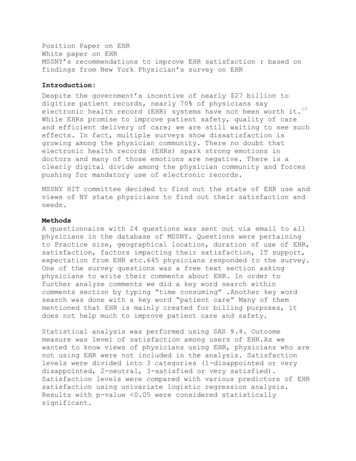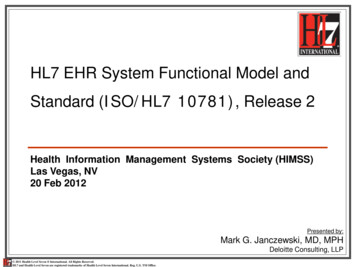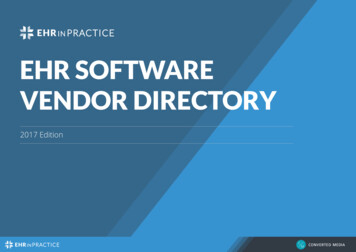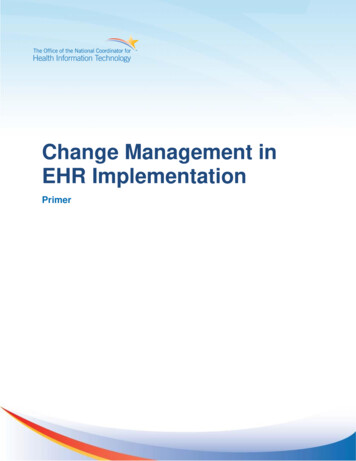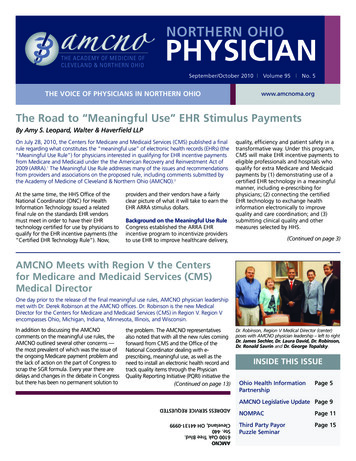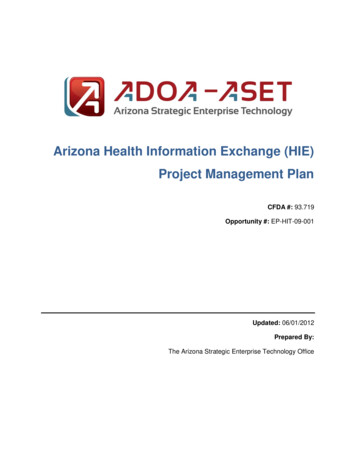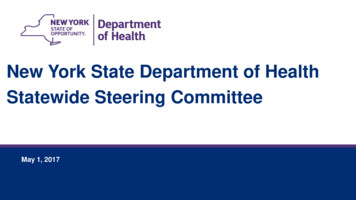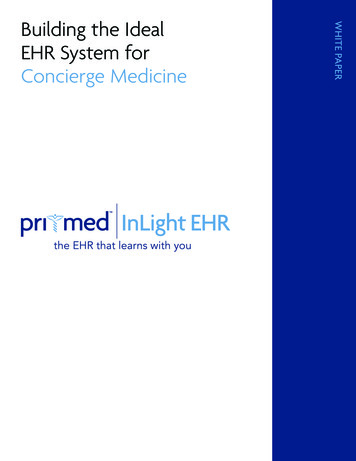
Transcription
WHITE PAPERBuilding the IdealEHR System forConcierge Medicine
WHITE PAPER: BUILDING THE IDEAL EHR SYSTEM FOR CONCIERGE MEDICINEContentsExecutive Summary 1EHRs fail Concierge Medicine 1Not designed for primary care 1Cognitive overload 2Not designed for concierge business model 2Designing an EHR system for Concierge Medicine 2Problems provide the answer 3Support for membership and billing 4Cloud-based for lower costs and less headache 5Support for “High-Touch” medicine 5Basic tools of the practice: interfaces, eRX, and faxes 6InLight EHR, Practice Essentials 6www.inlightehr.com ii
WHITE PAPER: BUILDING THE IDEAL EHR SYSTEM FOR CONCIERGE MEDICINEExecutive SummaryConcierge Medicine is poorly served by today’s Electronic Health Record (EHR) systems. Instead of improving the quality ofhealthcare delivery and making concierge physicians more efficient, EHR systems often have the opposite effect.Here at Pri-Med, we’ve taken a close look at concierge physicians and their clinical documentation systems. We came to a fewinteresting conclusions, which resulted in a “blueprint” for a better approach to EHR systems. By reading this white paper, youwill learn about: The unique challenges for concierge physicians using EHR systems; How EHR systems fail concierge physicians on two levels:–– the business of running a practice; and,–– the care delivered to patients; A new problem-based approach to EHR systems that can enhance professional satisfaction and improve patient care.EHRs fail Concierge MedicineEHR systems fail to meet needs of Concierge Medicine in two distinctly different ways. On one level, they do not help conciergephysicians practice better medicine. In fact, EHR systems can actually increase cognitive overload, which at best reduces theability to deliver high-touch medicine, and at worst leads to medical mistakes. On another level, EHR systems do not support thebusiness requirements of a concierge practice, such as retainer-billing options.Not designed for primary careWhy do so many concierge physicians see a permanent drop in productivity when they start using an EHR system? Why can’tthey use an EHR system to complete a note during the patient visit the way they could with a paper chart?Perhaps it’s because Concierge Medicine is really about delivering primary care, and most EHR systems are not designed withprimary care in mind. That’s why in a 2014 JAMA survey1 , family practice physicians reported an EHR-associated loss of 48 minutesof free time per clinic day.If EHR systems require doctors to spend more time on documentation than they did using paper charts, poor usability andbadly designed interfaces are the culprits. According to a 2013 Rand/AMA Study2 on Factors Affecting Physician ProfessionalSatisfaction, aspects of current EHR systems that were particularly common sources of dissatisfaction included: Poor usability Time-consuming data entry Interference with face-to-face patient careIf software is difficult to use, and forces users to take extra steps, it must by definition slow them down. The extra time spenttyping and clicking takes away from the finite amount of time concierge physicians can spend on all the other things that take uptheir busy x?articleid 1901114http://www.rand.org/pubs/research reports/RR439.htmlwww.inlightehr.com 1
WHITE PAPER: BUILDING THE IDEAL EHR SYSTEM FOR CONCIERGE MEDICINECognitive overloadPhysicians think in problems, but EHR systems organize patient data by source. For example, lab results for a particular patient arecommonly presented in a single list, regardless of the problems for which they were ordered. The same source-based organizingprinciple is used for medications, exam notes, orders, referrals, etc.As a result of this mismatch, many physicians are overwhelmed by how patient information is captured and presented byEHR systems.A concierge physician seeing a patient with three active problems must mentally juggle an average of twenty individualdata points during the visit. If she sees just five patients per day, she is handling more than 100 critically important pieces ofinformation. Miller’s Law famously states that the number of objects an average human can hold in working memory is 7 2, or amaximum of nine.No wonder concierge physicians often feel as if they are drowning in an ocean of disorganized EHR data when confronted withpatients having multiple problems. The capacity to effectively multitask is often stretched beyond its limits, leading to cognitiveoverload, which impairs the medical decision-making process and can lead to misdiagnosis, medical errors, and other potentiallylife-threatening mistakes.Not designed for concierge business modelA new model of practice requires a new approach to EHR systems. Unfortunately, the vast majority of EHR systems are notdesigned to support the unique requirements of the Concierge Medicine business model.According to Pri-Med research, over 80 percent of concierge physicians accept insurance in their practice, while the remaininghave cash-only, menu-style healthcare practices. Therefore, most concierge practices not only charge patients a monthly orannual retainer, but must also generate third-party insurance claims (i.e. CMS-1500 forms) for patients to submit to their carriers.EHR systems place too much emphasis on coding for maximum reimbursement. They frequently have coding roadblocks – suchas requiring a diagnosis code to close a chart. This increases the number of steps in the workflow and clicks required to getthrough a chart.Additionally, most EHR systems do not support the billing or management of patients as “retainers” of a concierge practice.There is no way to create different “tiers” of retainers, or use ACH withdrawals to collect retainer payments, or even collect cashpayments at the end of a visit.On the other hand, the small handful of EHR systems designed for the “direct care” market don’t include integrated fee-forservice billing, or integration with third-party practice management systems, leaving concierge practices unable to generateinsurance claims for patients.Designing an EHR system for Concierge MedicineWhat if you could close your eyes and imagine the perfect EHR system for Concierge Medicine physicians and their practices?What would it look like? What would it do?That’s exactly what we’ve done here at Pri-Med – we looked at the deficiencies of EHR systems, from both clinical and practicestandpoints, and how we could fix them. Then we reimagined the EHR system for Concierge Medicine. Here’s what it looks like:www.inlightehr.com 2
WHITE PAPER: BUILDING THE IDEAL EHR SYSTEM FOR CONCIERGE MEDICINEProblems provide the answerFor better care delivery, EHR systems require a problem-based approach to organizing and presenting patient information. Thisapproach changes how the concierge physician interacts with the EHR.In the problem-based approach to organizing information and workflow, all notes, medications, labs, orders, referrals, etc. areassociated with specific patient problems. The problem list provides a “table of contents” of specific relevant clinical issues thatcan be viewed longitudinally over time (see Figure 1).FIGURE 1: EHR SYSTEM WITH A PROBLEM LIST PROVIDES A QUICK SNAPSHOT OF A PATIENT’S AGENDA FOR THE VISIT(SCREEN COURTESY OF PRI-MED INLIGHT EHR)This intuitive interface allows the concierge physician and patient to set an agenda for the office visit and then review problemsin a way that supports the nonlinear nature of a medical encounter (see Figure 2).FIGURE 2: DETAIL OF A PATIENT CHART BASED ON A PROBLEM (SCREEN COURTESY OF PRI-MED INLIGHT EHR)Perhaps most importantly, an EHR that uses patient problems as its organizing principle can help reduce cognitive overload in theexam room. Concierge physicians will see patient health information associated with a specific problem(s), easing the number ofmental connections required to make a sound medical decision and, by extension, reducing risk of misdiagnosis and error.www.inlightehr.com 3
WHITE PAPER: BUILDING THE IDEAL EHR SYSTEM FOR CONCIERGE MEDICINESupport for membership and billingEHR systems should make it easy for concierge physicians to profitably operate and successfully grow their practices. The goalshould be to “Do good doctoring and get paid fairly for what you do.”The ideal EHR for concierge practices would support a hybrid approach to billing that includes the following elements: Comprehensive retainer management fully integrated with the clinical record in the EHR Support for a variety of retainer plans (individual, group, etc.), billing periods (monthly, annually, etc.) and discounts(see Figures 3 and 4); Centrally managed charges to allow for efficient ordering and prescription management Export charges to the Practice Management system of your choice; Print-out Medicare CMS-1500 forms; Free merchant integration; and, Easy cash receipts.FIGURE 3: EHR SYSTEM WITH RETAINER BILLING BY AGE (SCREEN COURTESY OF PRI-MED INLIGHT EHR)www.inlightehr.com 4
WHITE PAPER: BUILDING THE IDEAL EHR SYSTEM FOR CONCIERGE MEDICINEFIGURE 4: MULTIPLE LEVELS OF CONCIERGE RETAINER PLANS INTEGRATED WITH AN EHR SYSTEM(SCREEN COURTESY OF PRI-MED INLIGHT EHR)Cloud-based for lower costs and less headacheConcierge Medicine offices tend to be small in size. According to our research, 58 percent of concierge physicians have justone to two employees. These types of practices do not have the budget for expensive IT consultants.An ideal EHR system for concierge practices would be fully cloud-based, resulting in the following benefits: No need to purchase and maintain servers, routers, and other expensive hardware equipment; Eliminates IT headaches and the expense of hiring technicians; Always on the latest software version without cumbersome upgrades; and, Greater simplicity, easier training, and lower going operating costs.Support for “High-Touch” medicineOne of the joys of Concierge Medicine is the ability to practice “high-touch” medicine that gives patients a highly personalizedexperience. This means taking advantage of the latest technologies to allow concierge physicians and patients to communicateand track activities outside of the face-to face visit in the office.A cloud-based EHR, for example, gives a physician the freedom to access records anytime, anywhere on a tablet or Chromebook.This makes it easier to perform special services outside the office, such as house calls or hospital/nursing home visits.Next-generation patient engagement platforms like Twistle bring high-touch medicine to the next level with secure HIPAAcompliant email and text messaging with the capability to share pictures, videos, and documents.An EHR system designed for concierge practices should integrate all of these tools seamlessly, so lab results can be securely sentto a patient’s mobile phone with the push of a button.www.inlightehr.com 5
WHITE PAPER: BUILDING THE IDEAL EHR SYSTEM FOR CONCIERGE MEDICINEBasic tools of the practice: interfaces, eRX, and faxesOur research uncovered a few more features that concierge practices need in an EHR system: Direct interfaces with labs so results can be placed in the patient chart in real time, improving accuracy and resulting inbetter patient care; Electronic prescribing, which is preferred by most pharmacies today; and, Fax integration, allowing concierge practices to receive faxes electronically in the EHR inbox and replace paper.InLight EHR, Practice EssentialsThe goal of Concierge Medicine is for physicians to enjoy their practice and give their patients the high-touch health careexperience they expect. An EHR systems designed specifically for concierge practice has the potential to help a physician meetsthose goals, instead of holding them back.At Pri-Med, we used our knowledge of Concierge Medicine to build an EHR system that meets the meet the uniquerequirements of this special type of practice. InLight EHR Practice Essentials helps you: Reduce needless clicks, improve workflow, and solve for cognitive overload with a breakthrough problem-orientedapproach to information organization and presentation. Thrive financially with a hybrid approach to billing that includes both comprehensive management of retainerrelationships and the ability to export bills and print insurance submission forms. Lower operating expenses and reduce downtime with cloud technology that allows for anywhere, anytime access. Operate a concierge practice more efficiently with integrated tools and interfaces for patient engagement, ordering andlabs, eRX, and fax integration.To Learn MoreYou can start a free 45-day trial of the full version of InLight EHR Practice Essentials today. To learn more please call(844) 899-4448, or email sales@inlightehr.com, or visit www.inlightehr.com/concierge.www.inlightehr.com 6
DBC Pri-Med, LLC111 Huntington Ave.Boston, MA 021991-844-899-4448sales@inlightehr.com
The goal of Concierge Medicine is for physicians to enjoy their practice and give their patients the high-touch health care experience they expect. An EHR systems designed specifically for concierge practice has the potential to help a physician meets those goals, instead of holding them back.


